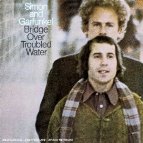When a songwriter pens a song which becomes a transatlantic chart-topper, let alone a multi-million seller, you’d think he’d be happy with the result, but Paul Simon always considered Bridge Over Troubled Water to be below the standards of others and wasn’t over the moon about it.
Paul’s then wife Peggy had rented a house on Blue Jay Way in Los Angeles, the house belonged to George Harrison and was the same house where George had penned Blue Jay Way for the Beatles Magical Mystery Tour EP. The song was created in 1969 in three different places. The writing of it happened on Los Angeles, the piano instrumental was laid down in a different area of Los Angeles and the vocals added in New York. The pianist was former Bread member and one-time ivory tinkler for Elvis, Larry Knechtel.
Paul, who wrote the song in the key of G on guitar and gave it the working title of Hymn, had Aretha Franklin in mind to sing it, but she turned it down and so Paul decided to record it with his partner in crime, Art Garfunkel. Incidentally Aretha did eventually record it the following year and took it to number six in the US chart and was rewarded with a Grammy for Best R&B vocal. Paul ‘borrowed’ the title from a line in the chorus of a 1958 song called Mary Don’t You Weep by Swan Silvertones and later said, “Had it not been for him (lead singer Claude Jeter) I would never have written Bridge Over Troubled Water, that guy probably has the best falsetto in the world.” He gave the music, which originally only had two verses and still called Hymn, to string arranger Jimmy Haskell to transpose it for piano. He had to change the key to E flat which is what Art Garfunkel sings in. Jimmy misheard the lyric and erroneously headed his sheet music, ‘Like a Pitcher Of Water’. That original sheet is now framed and resides at Paul Simon’s home.
The slow build of the song was inspired by the Righteous Brothers’ version of Ol’ Man River which was produced by Phil Spector and teases us with the gospel-tinged chorus by holding it back until near the end thus giving it maximum impact.
When it came to recording the vocals, Art was adamant that he should not sing the lead claiming that he wasn’t right for it and suggesting that Paul would be better. Paul insisted on Art doing it and so eventually gave in. Years later, Paul expressed much regret over his decision as it focused more on Art and thus relegating Paul to the background. The song came in for a bit of criticism as the press typically misinterpreted the lyric, ‘Sail on silver girl’ as being a drug reference. Actually is it Peggy who inspired the last verse when she told Paul that she’d noticed her first grey hairs coming through.
The parent album of the same name was the last the duo recorded before they split up, but it did become Columbia Records’ biggest selling album ever. It was also the first time an album and a single with the same title topped both the UK and US charts at the same time.
The song has been recorded by over 250 acts including Glen Campbell, Shirley Bassey, Josh Groban, Johnny Cash, Charlotte Church and the cast of Glee, but none bigger than Elvis Presley. His version appeared on his 1970 album That’s The Way It Is and this is what Paul Simon said about Elvis’ version, “It was in his Las Vegas period and done with conventional thinking. He sang it well, but it would have been nice to hear him do it Gospel because he did so many Gospel albums and was a good white Gospel singer. It would have been nice to hear him do it that way, to take it back, as opposed to the big ending; he seemed to end everything with a karate chop and an explosion. So he didn’t really add anything to the song. It’s not nearly as significant as the Aretha Franklin recording. It’s just a pleasure for me that Elvis Presley recorded one of my songs before he died.”
In 1973, Capital Radio, the first commercial station in London, was launched and Bridge… was the first song David Symonds played. Fifteen years later when the station split frequencies and Capital Gold started as a weekend service only, the same song opened that station.
On week ending 21 March 1970, Bridge moved from 2-3 and The Beatles’ Let It Be moved 3-2, ironically both songs were originally written for Aretha Franklin and she turned them both down, but ended up recording both of them at a later date. The lesson there is, if you want a big hit single; write it and offer it to Aretha in the hope she turns it down!
